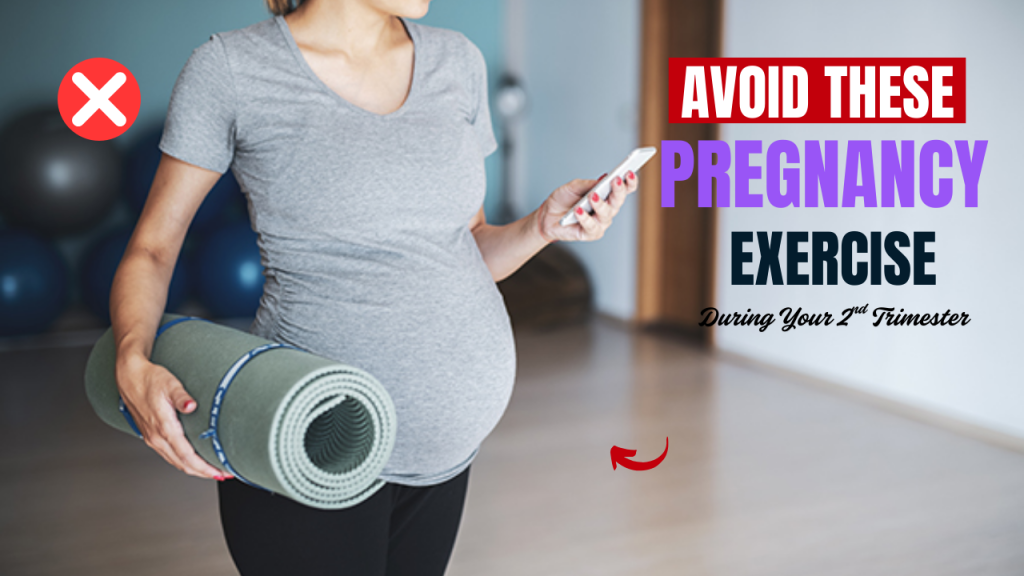Did you know that some popular fitness routines can actually do more harm than good during pregnancy—especially in the second trimester? While staying active is vital for a healthy pregnancy, not all movements are created equal. In fact, exercising the wrong way could increase your risk of injury, harm your baby, or lead to long-term complications.
Your second trimester (weeks 13 to 27) often feels like a golden period. Energy levels start to rise, morning sickness fades, and you might finally feel like moving your body again. But before you hit the gym or roll out your yoga mat, it’s crucial to know which exercises to strictly avoid during this stage. Let’s dive into the do-not list—and understand why skipping these can help you enjoy a safer, healthier pregnancy.

Table of Contents
Do’s and Don’ts During Your Second Trimester of Pregnancy
| Do’s | Don’ts |
|---|---|
| Do stay active with moderate exercise. Regular walking or prenatal yoga is great for your health. | Don’t do high-impact exercises. Avoid running, jumping, or anything that involves hard landings. |
| Do focus on core-strengthening exercises. Modify your routine to include safe core exercises like pelvic tilts. | Don’t lie flat on your back. This can restrict blood flow to your baby and cause dizziness. |
| Do listen to your body. If you feel discomfort, stop and consult your healthcare provider. | Don’t lift heavy weights. Excessive weightlifting can strain your muscles and increase pressure on your pelvic floor. |
| Do hydrate well and take rest breaks. Staying hydrated and rested during exercise is crucial for both you and the baby. | Don’t overheat. Avoid exercising in hot or humid environments, as overheating can harm fetal development. |
| Do perform low-impact cardio exercises. Swimming, walking, or stationary cycling are excellent choices. | Don’t engage in contact sports. Sports like basketball, soccer, or martial arts should be avoided due to the risk of injury. |
| Do prioritize your pelvic floor. Incorporate pelvic floor exercises like Kegels to strengthen this area. | Don’t twist your body excessively. Avoid deep twists or positions that compress your abdominal area. |
Types of Exercises to Avoid During 2nd Trimester
1. High-Impact Exercises (e.g., Running, Jumping Jacks, Box Jumps)

Your joints loosen during pregnancy due to the hormone relaxin, which makes high-impact movements risky. Jumping or running can strain your knees, hips, and pelvic floor.
Why to avoid:
- Increases the risk of falling or joint injuries.
- Can cause bladder leakage or pelvic floor damage.
- Elevates your heart rate and core temperature too much.
Myth Buster: “Running is safe throughout pregnancy if you were already a runner.”
Truth: Even seasoned runners need to dial it down during the second trimester to prevent pressure on the pelvic area and avoid balance-related accidents.
2. Exercises Lying Flat on Your Back

After the first trimester, lying flat on your back can compress the vena cava, a major vein that returns blood to your heart.
Why to avoid:
- Can cause dizziness, nausea, and reduced blood flow to the baby.
- May lead to low blood pressure (supine hypotension syndrome).
Examples to avoid:
- Traditional crunches
- Bench press
- Supine yoga poses like Savasana or Bridge
3. Heavy Weight Lifting or Straining Movements

Though strength training is great for pregnancy, lifting excessively heavy weights or performing exercises that require breath-holding (Valsalva maneuver) can be harmful.
Why to avoid:
- Causes intra-abdominal pressure which can strain your uterus.
- Increases risk of hernia or diastasis recti (abdominal separation).
- May result in dizziness or fainting.
Safer alternative: Use lighter weights with more repetitions and prioritize proper posture.
4. Twisting or Deep Core-Engaging Movements

Deep twisting compresses the belly, which can be dangerous during the second trimester when your uterus is expanding.
Why to avoid:
- Puts pressure on abdominal and uterine muscles.
- Increases risk of abdominal strain and back pain.
Avoid moves like:
- Bicycle crunches
- Russian twists
- Full sit-ups
Interesting Fact: During pregnancy, your core muscles are already stretched. Overworking them can slow recovery postpartum.
5. Contact or High-Risk Sports

Sports like basketball, soccer, martial arts, or even horseback riding might have been your favorite pre-pregnancy—but they’re a no-go now.
Why to avoid:
- High risk of collision or falls.
- Sudden jerky movements are dangerous for fetal development.
- Can lead to trauma or placental abruption.
Did you know?
Placental abruption (when the placenta detaches from the uterus) is rare but serious—and physical trauma is one of its leading causes.
6. Hot Yoga or Any Exercise in High Heat
Your body is already working overtime to regulate your internal temperature. Exercising in a heated environment can tip the balance.
Why to avoid:
- Risk of hyperthermia (overheating), which can be harmful to fetal development.
- Dehydration and dizziness are more likely.
Stay cool tip: Opt for prenatal yoga in a well-ventilated, air-conditioned room.
7. Balance-Dependent Workouts (e.g., Cycling, Skateboarding, Skiing)
As your belly grows, your center of gravity shifts. Exercises that require balance can suddenly become tricky—and unsafe.
Why to avoid:
- Increased risk of falling.
- Can injure both mother and baby in seconds.
Helpful Insight: Even indoor cycling can be dangerous if not modified for pregnancy. Always check with your doctor or trainer.
Exercises List to Avoid in the Second Trimester
| Exercise Type | Reason to Avoid |
|---|---|
| Running or Sprinting | Puts excessive strain on joints and can increase the risk of falls. |
| Jumping Jacks | High-impact movement that can strain pelvic floor and cause imbalance. |
| Box Jumps | Involves high-impact jumping, which increases the risk of injury and joint strain. |
| Crunches or Sit-ups | Puts pressure on the abdomen and may lead to diastasis recti or discomfort. |
| Twisting Movements (e.g., Russian Twists) | Can strain the abdominal and uterine muscles, increasing the risk of injury. |
| Lying on Your Back for Extended Periods | Compresses the vena cava, which can reduce blood flow to both you and the baby. |
| Heavy Weightlifting | Excessive weight lifting increases intra-abdominal pressure and risks pelvic floor strain. |
| High-Impact Aerobics or HIIT | Involves intense movements that can be hard on your joints and increase the risk of overheating. |
| Horseback Riding | High risk of falling and trauma to the abdomen. |
| Contact Sports (e.g., Soccer, Basketball) | Increased risk of falls, bumps, or trauma, which could harm the baby. |
| Rock Climbing | Risk of falling and exertion of pressure on the abdomen. |
| Cycling on Bumpy Surfaces | Increases the risk of falls or losing balance as your center of gravity shifts. |
| Hot Yoga or Bikram Yoga | Excessive heat can lead to overheating and dehydration, which is harmful during pregnancy. |
| Skateboarding or Skiing | Risk of falls and sudden jerky movements that may harm you or the baby. |
| Deep Squats with Heavy Weights | Straining your body with heavy weights can put excessive pressure on your pelvic region. |
Final Thoughts
Exercise during pregnancy is not about pushing limits—it’s about supporting your changing body and preparing for childbirth. The second trimester brings more stability and energy, but it also demands extra caution. By avoiding risky exercises, you’re not just protecting yourself—you’re laying the foundation for a healthy, empowered pregnancy journey.
Always consult your healthcare provider or a certified prenatal fitness specialist before starting or continuing any exercise routine. And remember, movement should feel good, not forced.
Empowered moms-to-be choose progress over perfection. Listen to your body—it always knows best.
Frequently Asked Questions (FAQs)
Is it safe to work out during the second trimester of pregnancy?
Yes, in most cases, moderate and well-guided exercise is safe and even beneficial. It can improve mood, sleep, posture, and help manage weight gain. However, it’s essential to avoid high-risk or strenuous movements and always consult your healthcare provider first.
Can I still do core workouts while pregnant?
Yes, but they should be modified. Avoid exercises that involve crunches, sit-ups, or twisting. Focus instead on gentle core strengthening like pelvic tilts, modified planks, and breathing-based core engagement.
Why is lying on my back during exercise not recommended?
Lying flat can compress the vena cava, a major vein that returns blood to your heart. This can cause dizziness, nausea, and reduced oxygen flow to the baby—especially after the first trimester.
Are prenatal yoga and Pilates safe in the second trimester?
Yes, prenatal-specific yoga and Pilates are generally safe and beneficial. They help improve flexibility, posture, and relaxation. Just avoid poses that involve lying flat, deep twists, or overstretching.
How often should I exercise during the second trimester?
If your pregnancy is healthy and approved by your doctor, aim for 20–30 minutes of moderate activity most days of the week. Gentle walking, swimming, and prenatal yoga are excellent choices.
Is it true that exercising can cause a miscarriage?
No, moderate and doctor-approved exercise does not increase the risk of miscarriage. However, overexertion or trauma from unsafe activities can cause complications, which is why certain exercises should be avoided.






Awesome
Very good
Awesome
Awesome
Very good